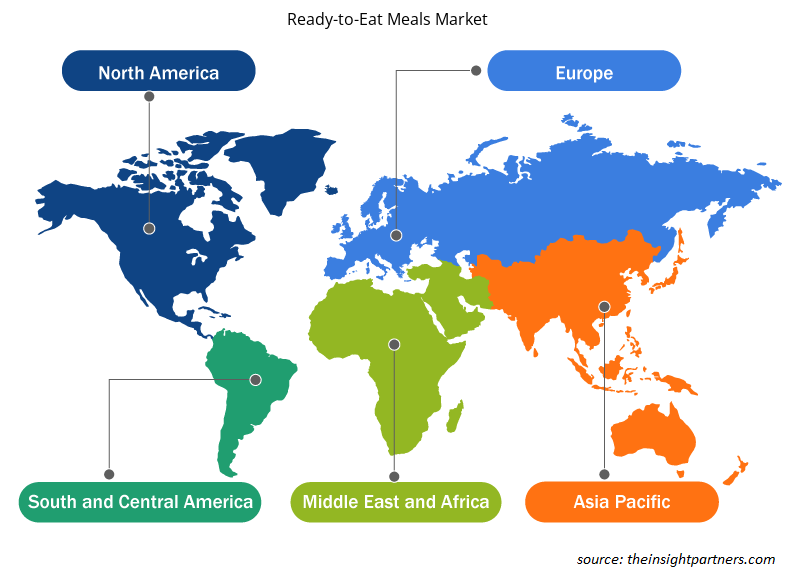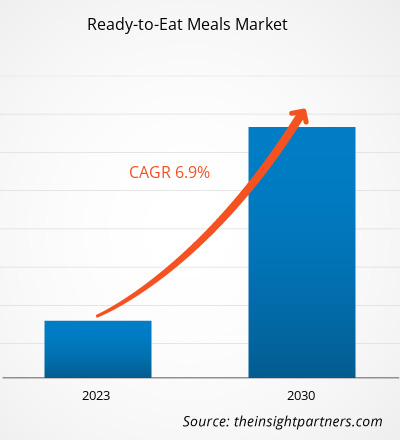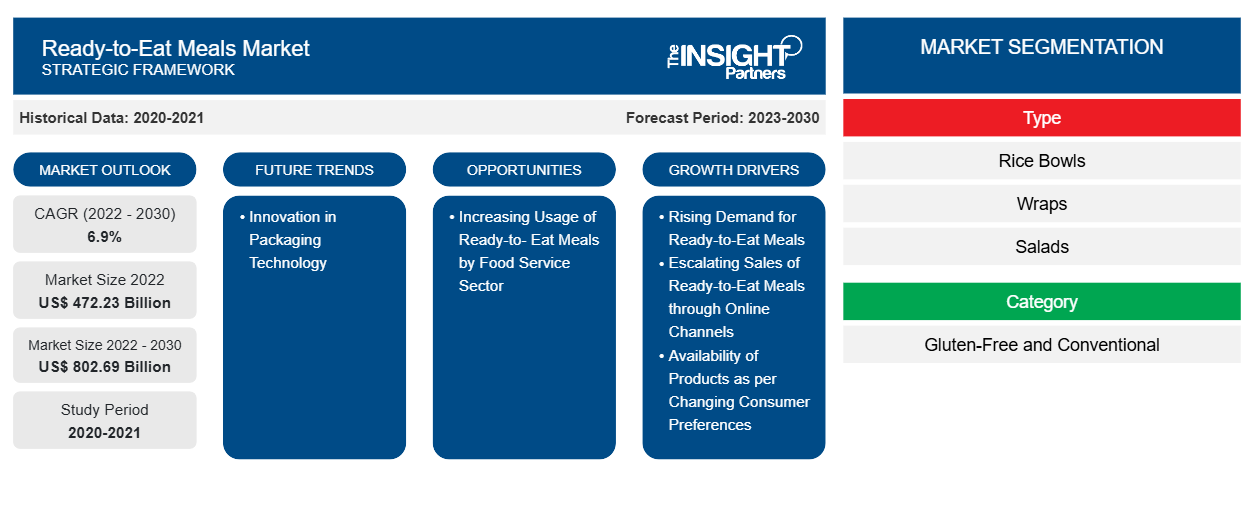[تقرير بحثي] من المتوقع أن ينمو سوق الوجبات الجاهزة للأكل من 472،231.63 مليون دولار أمريكي في عام 2022 إلى 802،689.21 مليون دولار أمريكي بحلول عام 2030؛ ومن المتوقع أن يسجل معدل نمو سنوي مركب بنسبة 6.9٪ من عام 2022 إلى عام 2030.
رؤى السوق ووجهة نظر المحلل:
الوجبات الجاهزة للأكل هي أطعمة سريعة التحضير يمكن تناولها أثناء التنقل ودون أي متاعب. السندويشات واللفائف والبيتزا والبرجر والمعكرونة والكاري والصلصات والبوريتو وأطباق الأرز هي بعض الوجبات الجاهزة للأكل التي يتم تناولها على نطاق واسع. لقد تغير نمط حياة الناس في جميع أنحاء العالم بشكل كبير بسبب قطاع الشركات المتنامي، والعدد المتزايد من الأسر ذات الدخل المزدوج، وساعات العمل الممتدة. يفضل الناس الوجبات الجاهزة للأكل لتجنب وقت الطهي والجهد. ساهم هذا العامل بشكل كبير في نمو سوق الوجبات الجاهزة للأكل العالمية.
بناءً على الفئة، يتم تصنيف سوق الوجبات الجاهزة للأكل إلى وجبات خالية من الجلوتين ووجبات تقليدية. إن الانتشار المتزايد لعدم تحمل الجلوتين في المنطقة، إلى جانب الوعي المتزايد بالفوائد الصحية للمنتجات الخالية من الجلوتين، هي العوامل الرئيسية التي تدفع الطلب على الوجبات الجاهزة للأكل الخالية من الجلوتين. كما أنه مع حصول المستهلكين على وصول أكثر شمولاً إلى مجموعة متنوعة من العلامات التجارية للوجبات الجاهزة للأكل الخالية من الجلوتين، من المتوقع أن تشهد الفئة نموًا هائلاً في السنوات القادمة.
قم بتخصيص هذا التقرير ليناسب متطلباتك
ستحصل على تخصيص لأي تقرير - مجانًا - بما في ذلك أجزاء من هذا التقرير، أو تحليل على مستوى الدولة، وحزمة بيانات Excel، بالإضافة إلى الاستفادة من العروض والخصومات الرائعة للشركات الناشئة والجامعات
-
احصل على أهم اتجاهات السوق الرئيسية لهذا التقرير.ستتضمن هذه العينة المجانية تحليلاً للبيانات، بدءًا من اتجاهات السوق وحتى التقديرات والتوقعات.
محركات النمو والتحديات:
أصبح استهلاك الأطعمة الجاهزة عالية الجودة أحد أكبر الاتجاهات في صناعة الأغذية. تتيح الأطعمة الجاهزة، مثل المنتجات الجاهزة للأكل والوجبات الجاهزة للأكل والمنتجات المجمدة، للمستهلكين توفير الوقت والجهد المرتبطين بالتسوق للمكونات وإعداد الوجبات والطهي والاستهلاك والأنشطة بعد الوجبة. تعد الراحة والذوق من أهم السمات المرغوبة بين المستهلكين في جميع أنحاء العالم عند شراء الطعام. وفقًا لمسح الغذاء والصحة الذي أجراه "المجلس الدولي لمعلومات الأغذية ( IFIC )"، فإن الراحة هي المحرك الرئيسي لجيل الألفية عند شراء الطعام. في الوقت نفسه، يعد الذوق ضروريًا لجيل طفرة المواليد.
وقد استفادت خدمات توصيل السوبر ماركت ــ مثل أمازون فريش وإنستاكارت ــ وشركات توصيل وجبات الطعام ــ مثل بلو إبرون ــ من التفضيل المتزايد للراحة والجودة. وعلاوة على ذلك، تجد هذه الشركات سهولة في التعامل مع الأطعمة الجاهزة بسبب وجود سلاسل إمداد باردة متطورة. وتعزز مثل هذه العوامل الطلب على الأطعمة الجاهزة في جميع أنحاء العالم.
تكتسب الأطعمة الجاهزة مثل الوجبات الجاهزة للأكل شعبية متزايدة بسبب العدد المتزايد من الأسر الصغيرة والأسر ذات الدخل المزدوج في جميع أنحاء العالم. ونظرًا لجداول عملهم المزدحمة، يفضل جيل الألفية أن يكونوا فعالين في استخدام وقتهم وتجنب المهام المملة. تتم معالجة الوجبات الجاهزة للأكل وتنطوي على تقنية الحفظ، وبالتالي إطالة عمر المنتج. كما ساعدت الجهود والوقت الذي تم توفيره في تحضير الطعام وسهولة تخزينه ونقله في زيادة الطلب عليه. ووفقًا لـ "مسح الغذاء والصحة لعام 2020" الذي أجراه المجلس الدولي لمعلومات الغذاء، من بين 1011 أمريكيًا (تتراوح أعمارهم بين 18 و80 عامًا)، تناول 19٪ من المستهلكين المزيد من الوجبات الجاهزة من مخزنهم أو الفريزر.
وفقًا لاستطلاع عام 2020 الذي أجرته شركة Eating Better's Ready Meals Snapshot، يتناول 88% من البالغين في المملكة المتحدة وجبات إفطار وعشاء جاهزة للأكل أو أطعمة جاهزة للطهي. ويتناول اثنان من كل خمسة أشخاص وجبات معلبة وجاهزة للأكل كل أسبوع. وبالتالي، فإن الطلب المتزايد على الأطعمة الجاهزة، مثل الوجبات الجاهزة للأكل، لتوفير الوقت والجهد، يحرك سوق الوجبات الجاهزة للأكل في جميع أنحاء العالم.
هناك زيادة كبيرة في عدد المهنيين العاملين في الولايات المتحدة من أمريكا الشمالية. وفقًا لوزارة العمل والتنمية الاجتماعية الكندية ( ESDC )، في كندا، تم الإبلاغ عن معدل مشاركة القوى العاملة بين الإناث والذكور بنسبة 88.142٪ في عام 2022 وسجل زيادة عن الرقم السابق البالغ 87.075٪ في عام 2021. أدى العدد المتزايد من السكان العاملين إلى زيادة الطلب على الأطعمة الجاهزة مثل الوجبات الجاهزة للأكل، مما يساعد في توفير الوقت والجهد. جعلت قنوات التوزيع الراسخة، مثل محلات السوبر ماركت والهايبر ماركت وتجارة التجزئة عبر الإنترنت، هذه المنتجات في متناول مختلف الأسر في المنطقة، مما دفع سوق الوجبات الجاهزة للأكل في أمريكا الشمالية. اكتسبت منصات التسوق عبر الإنترنت قوة جذب هائلة خلال جائحة كوفيد-19. وفقًا لخدمات الزراعة الخارجية الأمريكية ، شهدت صناعة الأغذية بالتجزئة الكندية في عام 2022 عودة مركزة، حيث بلغ إجمالي المبيعات حوالي 29.5 مليار دولار أمريكي، بزيادة قدرها 20.9٪ عن عام 2021. وبالتالي، فإن صناعة التجزئة الكندية متنوعة للغاية ومن المتوقع أن تقدم فرصًا جديدة لسوق الوجبات الجاهزة للأكل. وبالتالي، فإن جميع العوامل المذكورة أعلاه تزيد من نمو سوق الوجبات الجاهزة للأكل.
تقسيم التقرير ونطاقه:
"سوق الوجبات الجاهزة للأكل العالمية" مقسمة على أساس النوع والفئة والمستخدم النهائي والجغرافيا. بناءً على النوع، يتم تقسيم السوق إلى أطباق الأرز واللفائف والسلطات والبوريتو والمرق والكاري والمعكرونة والبيتزا والحساء واليخنات وأطباق اللحوم والبرغر والسندويشات وغيرها. احتل قطاع المعكرونة والمعكرونة الحصة الأكبر من سوق الوجبات الجاهزة للأكل العالمية. بناءً على الجغرافيا، يتم تقسيم سوق الوجبات الجاهزة للأكل إلى أمريكا الشمالية (الولايات المتحدة وكندا والمكسيك) وأوروبا (ألمانيا وفرنسا وإيطاليا والمملكة المتحدة وروسيا وبقية أوروبا) وآسيا والمحيط الهادئ (أستراليا والصين واليابان والهند وكوريا الجنوبية وبقية آسيا والمحيط الهادئ) والشرق الأوسط وأفريقيا (جنوب أفريقيا والمملكة العربية السعودية والإمارات العربية المتحدة وبقية الشرق الأوسط وأفريقيا) وأمريكا الجنوبية والوسطى (البرازيل وتشيلي وبقية أمريكا الجنوبية والوسطى).
التحليل القطاعي :
بناءً على النوع، يتم تقسيم سوق الوجبات الجاهزة للأكل إلى أطباق الأرز واللفائف والسلطات والبوريتو والمرق والكاري والمعكرونة والبيتزا والحساء واليخنات وأطباق اللحوم والبرغر وغيرها. احتل قطاع المعكرونة والمعكرونة الحصة الأكبر من سوق الوجبات الجاهزة للأكل في عام 2022. ومن المتوقع أن يسجل قطاع السلطات معدل نمو سنوي مركب أعلى خلال فترة التوقعات. تتوفر وجبات المعكرونة الجاهزة للأكل بأنواع مختلفة، مثل السباغيتي والبيني والفيتوتشيني والمكرونة. تشمل وجبات المعكرونة مصادر البروتين مثل الجمبري وكرات اللحم والدجاج ومصادر البروتين النباتي . تم تصميم وجبات المعكرونة المعبأة للتقديم السريع وتتطلب الحد الأدنى من الطهي. يتم تقديم وجبات المعكرونة الجاهزة للأكل في حاويات فردية، مما يجعل التحكم في الحصص وإعادة التسخين أسهل. تعد عادات استهلاك الطعام المتغيرة وأنماط الحياة المزدحمة والتعرض لثقافات متنوعة وزيادة الطلب على المأكولات المتنوعة والأطعمة الجاهزة من العوامل الرئيسية التي تدفع الطلب على المعكرونة الجاهزة للأكل. يطلق المصنعون المعكرونة الجاهزة للأكل في عدة فئات، مثل المعكرونة النباتية أو الخالية من الغلوتين أو العضوية، مما يجعلها خيارًا أكثر ملاءمة للوجبات.
التحليل الإقليمي:
تم تقسيم سوق الوجبات الجاهزة للأكل إلى خمس مناطق رئيسية - أمريكا الشمالية وأوروبا وآسيا والمحيط الهادئ وأمريكا الجنوبية والوسطى والشرق الأوسط وأفريقيا. هيمنت منطقة آسيا والمحيط الهادئ على سوق الوجبات الجاهزة للأكل العالمية وقُدِّرت قيمتها بنحو 150 مليار دولار أمريكي في عام 2022. تم تقسيم سوق الوجبات الجاهزة للأكل في منطقة آسيا والمحيط الهادئ إلى أستراليا والصين والهند واليابان وكوريا الجنوبية وبقية منطقة آسيا والمحيط الهادئ. يدفع التوسع الحضري المتزايد وارتفاع الدخل المتاح لسكان الطبقة المتوسطة الطلب على الوجبات الجاهزة للأكل، بما في ذلك البرغر والسندويشات والمعكرونة والمعكرونة والبيتزا. وفقًا لمنظمة العمل الدولية، ارتفع إجمالي دخل دول منطقة آسيا والمحيط الهادئ بنسبة 3.5٪ في عام 2021، حيث شكلت الصين 0.3٪ في عام 2021 و0.7٪ في النصف الأول من عام 2022.
وارتفع إجمالي الدخل بنسبة 12.4% في وسط وغرب آسيا. ويفضل المهنيون العاملون خيارات الطعام المريحة مثل أطباق الأرز واللفائف والسلطات واللفائف والمرق والكاري والمعكرونة والبيتزا، فضلاً عن الحساء واليخنات، وذلك بسبب ارتفاع الدخل المتاح والقيود الزمنية وجداول العمل المزدحمة.
من حيث الفرص، تتمتع سوق الوجبات الجاهزة للأكل في منطقة آسيا والمحيط الهادئ بإمكانات كبيرة للابتكار. يركز المصنعون على تطوير المنتجات لتقديم نكهات ومكونات وتقنيات طهي جديدة لتلبية أذواق وتفضيلات المستهلكين المتنوعة. علاوة على ذلك، فإن استهداف المؤسسات مثل المدارس والكليات والمكاتب التجارية بحلول وجبات مخصصة يخلق مصدر دخل جديد للشركات العاملة في سوق الوجبات الجاهزة للأكل في منطقة آسيا والمحيط الهادئ.
إن تأثير أنماط الحياة والمأكولات الغربية يشكل عاملاً رئيسياً آخر يعزز الطلب على منتجات الوجبات الجاهزة للأكل في منطقة آسيا والمحيط الهادئ. ومع ذلك، فإن حساسية الأسعار بين المستهلكين تشكل تحديًا كبيرًا لتقدم صناعة الوجبات الجاهزة للأكل في منطقة آسيا والمحيط الهادئ.
تطورات الصناعة والفرص المستقبلية:
فيما يلي قائمة بالمبادرات المختلفة التي اتخذها اللاعبون الرئيسيون العاملون في سوق الوجبات الجاهزة للأكل العالمية:
- في ديسمبر 2020، أطلقت شركة نستله خط إنتاج الوجبات الجاهزة للأكل من إنتاج هارفست جورميه في الصين. ويشمل خط الإنتاج البرجر والنقانق والناجتس واللحم المفروم والخيارات النباتية مثل دجاج كونغ باو وكرات اللحم المطهية ولحم الخنزير المقدد والمقلاة الحارة.
- في يونيو 2021، أطلقت شركة تصنيع الأغذية الأمريكية "Tyson Foods, Inc." وجبات نباتية جاهزة للأكل في منطقة آسيا والمحيط الهادئ.
- في ديسمبر 2020، أطلقت شركة Freshly Inc.، وهي شركة تابعة لشركة Nestle SA، خدمة توصيل الوجبات الجاهزة للأكل، منتجات الوجبات الجاهزة للأكل. هذه العروض خالية من الغلوتين، ومصنوعة من مكونات غذائية كاملة.
رؤى إقليمية حول سوق الوجبات الجاهزة للأكل
لقد قام المحللون في Insight Partners بشرح الاتجاهات والعوامل الإقليمية المؤثرة على سوق الوجبات الجاهزة للأكل طوال فترة التوقعات بشكل شامل. يناقش هذا القسم أيضًا قطاعات سوق الوجبات الجاهزة للأكل والجغرافيا في جميع أنحاء أمريكا الشمالية وأوروبا ومنطقة آسيا والمحيط الهادئ والشرق الأوسط وأفريقيا وأمريكا الجنوبية والوسطى.

- احصل على البيانات الإقليمية المحددة لسوق الوجبات الجاهزة للأكل
نطاق تقرير سوق الوجبات الجاهزة للأكل
| سمة التقرير | تفاصيل |
|---|---|
| حجم السوق في عام 2022 | 472.23 مليار دولار أمريكي |
| حجم السوق بحلول عام 2030 | 802.69 مليار دولار أمريكي |
| معدل النمو السنوي المركب العالمي (2022 - 2030) | 6.9% |
| البيانات التاريخية | 2020-2021 |
| فترة التنبؤ | 2023-2030 |
| القطاعات المغطاة |
حسب النوع
|
| المناطق والدول المغطاة |
أمريكا الشمالية
|
| قادة السوق وملفات تعريف الشركات الرئيسية |
|
كثافة اللاعبين في سوق الوجبات الجاهزة للأكل: فهم تأثيرها على ديناميكيات الأعمال
يشهد سوق الوجبات الجاهزة للأكل نموًا سريعًا، مدفوعًا بالطلب المتزايد من جانب المستخدم النهائي بسبب عوامل مثل تفضيلات المستهلكين المتطورة والتقدم التكنولوجي والوعي المتزايد بفوائد المنتج. ومع ارتفاع الطلب، تعمل الشركات على توسيع عروضها والابتكار لتلبية احتياجات المستهلكين والاستفادة من الاتجاهات الناشئة، مما يؤدي إلى زيادة نمو السوق.
تشير كثافة اللاعبين في السوق إلى توزيع الشركات أو المؤسسات العاملة في سوق أو صناعة معينة. وهي تشير إلى عدد المنافسين (اللاعبين في السوق) الموجودين في مساحة سوق معينة نسبة إلى حجمها أو قيمتها السوقية الإجمالية.
الشركات الرئيسية العاملة في سوق الوجبات الجاهزة للأكل هي:
- شركة تايسون فودز
- الأطعمة المبردة SK
- شركة فريش جريل فوودز ذ.م.م
- شركة داندي ساندويتش
- مزارع تايلور
إخلاء المسؤولية : الشركات المذكورة أعلاه ليست مرتبة بأي ترتيب معين.

- احصل على نظرة عامة على أهم اللاعبين الرئيسيين في سوق الوجبات الجاهزة للأكل
تأثير جائحة كوفيد-19:
أثرت جائحة كوفيد-19 على الاقتصادات والصناعات في مختلف البلدان. أثرت عمليات الإغلاق وحظر السفر وإغلاق الأعمال في الدول الرائدة في أمريكا الشمالية وأوروبا ومنطقة آسيا والمحيط الهادئ وأمريكا الجنوبية والوسطى والشرق الأوسط وأفريقيا سلبًا على نمو مختلف الصناعات، بما في ذلك الأغذية والمشروبات. أدى إغلاق وحدات التصنيع إلى اضطراب سلاسل التوريد العالمية وأنشطة التصنيع وجداول التسليم ومبيعات مختلف المنتجات الأساسية وغير الأساسية. أعلنت شركات مختلفة عن تأخيرات محتملة في تسليم المنتجات وانخفاض في المبيعات المستقبلية لمنتجاتها في عام 2020. بالإضافة إلى ذلك، أجبر الحظر الذي فرضته حكومات مختلفة في أوروبا ومنطقة آسيا والمحيط الهادئ وأمريكا الشمالية على السفر الدولي الشركات على تعليق خطط التعاون والشراكة مؤقتًا. علاوة على ذلك، أثر إغلاق المسالخ بسبب الإغلاق سلبًا على نمو السوق. كل هذه العوامل أعاقت صناعة الأغذية والمشروبات في عام 2020 وأوائل عام 2021، وبالتالي كبح جماح نمو سوق الوجبات الجاهزة للأكل.
المنافسة والشركات الرئيسية:
تعد شركة Tyson Foods Inc. وSK Chilled Foods وFresh Grill Foods LLC وDandee Sandwich Co. وTaylor Farms وCalavo Growers Inc. وHearthside Food Solutions LLC وEA Sween وFreshRealm وTripleSticks من بين اللاعبين البارزين الذين يعملون في سوق الوجبات الجاهزة للأكل العالمية. تقدم شركات تصنيع الوجبات الجاهزة للأكل حلول مستخلصات متطورة بميزات مبتكرة لتقديم تجربة فائقة للمستهلكين.
- التحليل التاريخي (سنتان)، سنة الأساس، التوقعات (7 سنوات) مع معدل النمو السنوي المركب
- تحليل PEST و SWOT
- حجم السوق والقيمة / الحجم - عالمي، إقليمي، بلد
- الصناعة والمنافسة
- مجموعة بيانات إكسل
التقارير الحديثة
شهادات العملاء
سبب الشراء
- اتخاذ قرارات مدروسة
- فهم ديناميكيات السوق
- تحليل المنافسة
- رؤى العملاء
- توقعات السوق
- تخفيف المخاطر
- التخطيط الاستراتيجي
- مبررات الاستثمار
- تحديد الأسواق الناشئة
- تحسين استراتيجيات التسويق
- تعزيز الكفاءة التشغيلية
- مواكبة التوجهات التنظيمية























 احصل على عينة مجانية ل - سوق الوجبات الجاهزة للأكل
احصل على عينة مجانية ل - سوق الوجبات الجاهزة للأكل